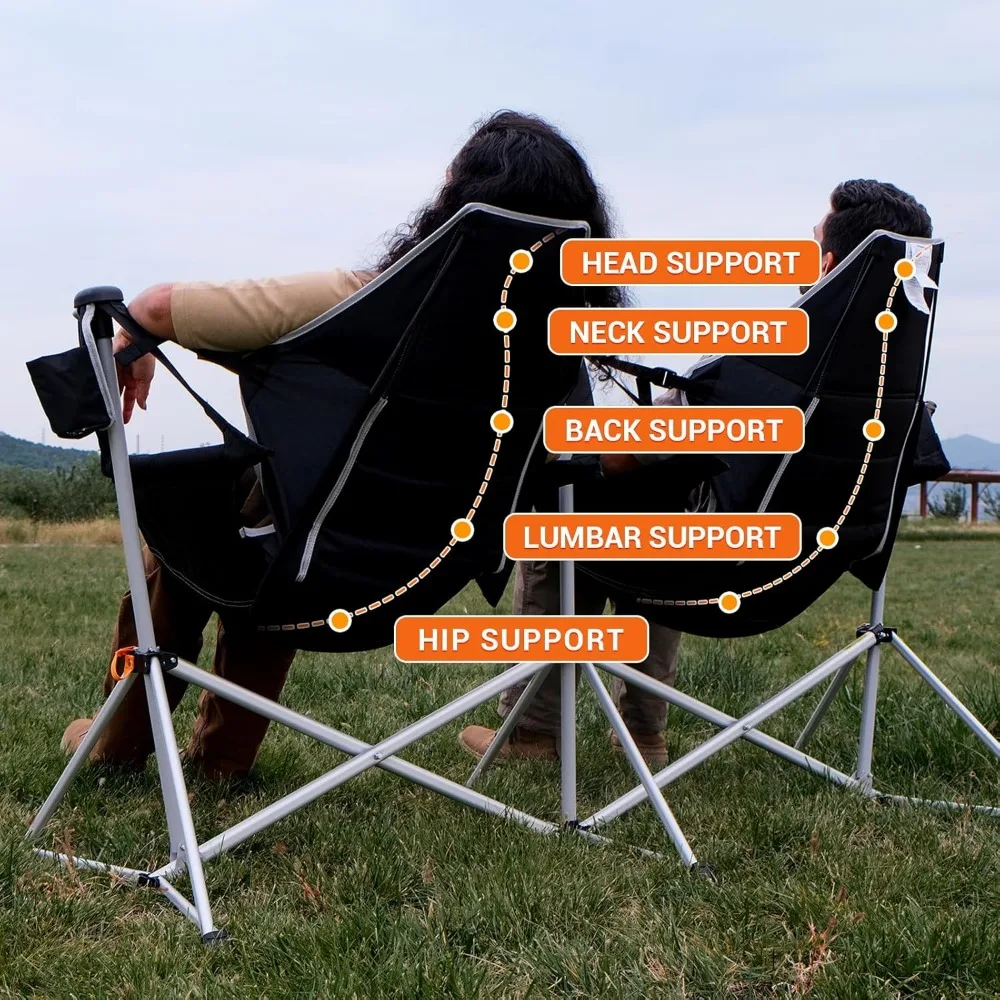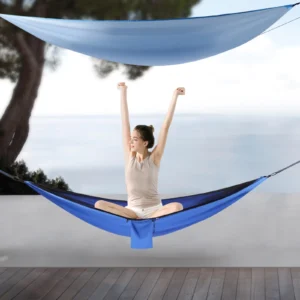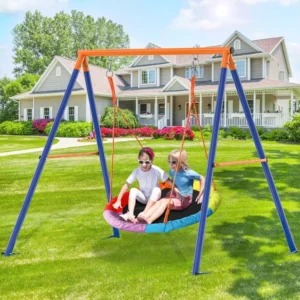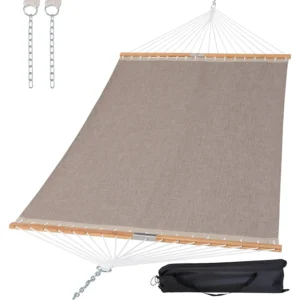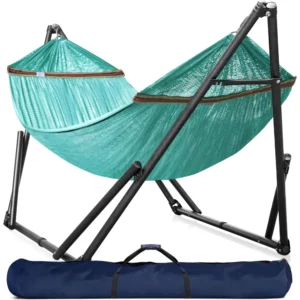Introduction: Why Folding Hammocks Are a Road Trip Essential
Road trips offer freedom and adventure, but those long stretches behind the wheel can leave you stiff and yearning for comfortable rest breaks. This is where folding hammocks come in—transforming ordinary roadside stops into refreshing relaxation experiences.
Unlike traditional hammocks that require permanent installation, road-trip-friendly folding options are designed specifically for portability and quick setup. They come in various styles: some with integrated stands that set up anywhere, others that pack down incredibly small for hanging between trees, and hybrid options offering the best of both worlds.
The right folding hammock can dramatically change your travel experience. Imagine pulling over at a scenic overlook and within minutes lounging comfortably with an elevated view rather than sitting on the ground or in your car. These portable systems let you truly immerse yourself in beautiful surroundings while giving your body a break from driving posture.
When selecting the hammocks for this guide, we evaluated each option based on portability, setup speed, comfort level, durability under travel conditions, and overall value. The indoor-outdoor hammock placement possibilities are nearly endless when you have a system designed for mobility.
Road travelers have increasingly embraced folding hammocks in recent years, recognizing their unique ability to transform any stop into an opportunity for quality rest. Whether you’re looking for ultra-lightweight simplicity or complete stand-integrated systems, our guide will help you find the perfect portable relaxation solution for your journey.
Our Top 6 Folding Hammocks for Road Trip Adventures
We’ve carefully evaluated dozens of folding hammocks to identify the best options for road travelers. Each selection underwent rigorous testing across multiple road trips, in varied weather conditions, and with repeated setup and takedown cycles.
Our criteria focused on what matters most during travel: how small the hammock packs, how quickly you can set it up, comfort during use, durability over time, and weight capacity for different users. The following selections represent diverse approaches to portable relaxation, with options to suit various needs, preferences, and budgets.
Before choosing any hammock for your adventures, understanding proper hammock installation requirements and safety guidelines is essential to ensure both enjoyment and security during your road trip breaks.
Best Overall: Premium Portable Hammock with Quick-Deploy Stand
This all-in-one system stands out as the perfect road trip companion, combining exceptional ease of use with true go-anywhere versatility. The integrated frame unfolds in under two minutes, providing reliable relaxation without requiring trees or other anchor points.
Specifications:
– Packed dimensions: 34 × 8 × 8 inches (86.4 × 20.3 × 20.3 cm)
– Deployed dimensions: 94 × 31 × 40 inches (238.8 × 78.7 × 101.6 cm)
– Weight: 26 pounds (11.8 kg)
– Weight capacity: 300 pounds (136 kg)
– Setup time: Under 2 minutes
Pros:
– Self-standing design works anywhere (beaches, rest stops, campgrounds)
– Tool-free setup with intuitive folding mechanism
– Weather-resistant materials suitable for varied climates
– Integrated carrying case doubles as storage while relaxing
– Stable base performs well on multiple surfaces
Cons:
– Heavier than tree-hanging alternatives
– Requires more vehicle storage space than fabric-only options
This hammock system excels during road trips where you want maximum flexibility with minimal setup hassle. The clever engineering allows one person to deploy it almost instantly upon arriving at a scenic overlook or rest area. The substantial frame provides reassuring stability, while the quality hammock fabric offers surprising comfort for afternoon naps or stargazing breaks.
Our folding hammock sets collection includes several variations on this design concept, but this model’s balance of portability and usability makes it our top overall recommendation.
Best Lightweight: Ultracompact Foldable Travel Hammock
For travelers prioritizing minimal weight and storage space, this ultralight hammock delivers exceptional packability without sacrificing comfort. When compressed, it’s scarcely larger than a smartphone, making it perfect for vehicles where space is at a premium.
Specifications:
– Packed dimensions: 5 × 4 × 2 inches (12.7 × 10.2 × 5.1 cm)
– Deployed dimensions: 108 × 54 inches (274.3 × 137.2 cm)
– Weight: 10 ounces (283 grams)
– Weight capacity: 300 pounds (136 kg)
– Setup time: 3-5 minutes (including finding suitable anchor points)
Pros:
– Incredibly small packed size fits in glove compartment or daypack
– Triple-stitched seams provide surprising durability
– Includes lightweight aluminum carabiners and tree-friendly straps
– Quick-dry nylon material ideal for unpredictable weather
– Multiple vibrant color options available
Cons:
– Requires trees or other substantial anchor points
– Slightly more complex setup than stand-integrated options

This featherweight option is perfect for minimalist travelers or those with compact vehicles where every inch of storage space counts. Despite its tiny packed size, it unfurls into a surprisingly spacious lounging environment capable of supporting most adults comfortably.
The included tree straps and carabiners eliminate the need for additional purchases, though setup does require finding suitable anchor points. For travelers focusing on national parks, wooded campgrounds, or other natural areas, our ultralight camping hammock sets provide unbeatable portability for spontaneous relaxation opportunities.
Best Hammock with Stand: All-in-One Folding System
This innovative system solves the biggest challenge of road trip hammocking—finding suitable hanging points—by including a cleverly designed stand that balances portability with stability. The entire system folds into a single unit that fits easily in most vehicle trunks.
Specifications:
– Packed dimensions: 40 × 6 × 6 inches (101.6 × 15.2 × 15.2 cm)
– Deployed dimensions: 95 × 31 × 35 inches (241.3 × 78.7 × 88.9 cm)
– Weight: 21 pounds (9.5 kg)
– Weight capacity: 275 pounds (124.7 kg)
– Setup time: Under 3 minutes
Pros:
– Complete solution requires no trees or anchor points
– Superior stability on varied surfaces (beaches, grass, gravel)
– Single-piece design prevents lost components
– Tool-free assembly with intuitive locking mechanisms
– Weather-resistant frame with powder-coated finish
Cons:
– Heavier than traditional fabric hammocks
– Requires more storage space than simple hammock systems
The ability to unfold your adventure with a folding hammock anywhere makes this system uniquely valuable for road travelers who appreciate flexibility. Whether you’re stopping at a treeless rest area, desert landscape, or rocky coastline, this system ensures you can always enjoy elevated relaxation without compromise.
The steel frame components use an innovative folding mechanism that balances strength with portability, while the attached hammock features soft yet durable fabric that provides excellent support for extended lounging sessions.
Best Double Hammock: Spacious Two-Person Folding Design
Perfect for couples or those who simply prefer extra lounging space, this generous double hammock offers substantial width without significantly increasing packed size. The reinforced construction handles two adults comfortably while remaining reasonable to transport.
Specifications:
– Packed dimensions: 8 × 6 × 4 inches (20.3 × 15.2 × 10.2 cm)
– Deployed dimensions: 120 × 78 inches (304.8 × 198.1 cm)
– Weight: 25 ounces (708 grams)
– Weight capacity: 500 pounds (226.8 kg)
– Setup time: 4-6 minutes
Pros:
– Expansive width accommodates two adults comfortably
– Reinforced stitching supports substantial weight capacity
– Surprisingly compact when packed despite larger deployed size
– Premium-grade ripstop nylon resists tearing and stretching
– Includes extra-long tree straps for flexibility in hanging locations
Cons:
– Requires sturdier anchor points than single hammocks
– Slightly heavier and bulkier than solo options
This spacious hammock proves that bringing comfort for two doesn’t necessarily mean sacrificing portability. When paired with our portable hammocks stands, this system becomes an ideal solution for couples road-tripping together who want to share relaxation moments without crowding each other.
The extra width also benefits solo loungers who prefer diagonal positioning for a flatter, more bed-like experience. Despite its generous proportions when deployed, thoughtful design allows this hammock to compress remarkably well for storage between stops.
Best Budget-Friendly: Affordable Road Trip Relaxation
Quality relaxation doesn’t have to break the bank, as this value-focused hammock demonstrates. Perfect for occasional travelers or those just exploring hammock lounging, it delivers the essential experience without unnecessary premium features or costs.
Specifications:
– Packed dimensions: 7 × 5 × 3 inches (17.8 × 12.7 × 7.6 cm)
– Deployed dimensions: 108 × 55 inches (274.3 × 139.7 cm)
– Weight: 18 ounces (510 grams)
– Weight capacity: 250 pounds (113.4 kg)
– Setup time: 3-4 minutes
Pros:
– Exceptional value without compromising essential functionality
– Respectable durability with proper care
– Simple design focuses on what matters most
– Includes basic suspension straps
– Lightweight and reasonably compact for travel
Cons:
– Less refined stitching than premium alternatives
– Basic suspension system may require upgrades for frequent users
This hammock proves that entry-level options can still deliver meaningful relaxation experiences. While it lacks some refinements of higher-priced alternatives, it covers the fundamentals well—comfortable support, reasonable durability, and adequate portability for road trip use.
It’s particularly well-suited for those new to hammock lounging who want to explore the concept before investing in premium equipment. With proper care and realistic expectations about its limitations, this budget-friendly option can provide many enjoyable breaks during your journeys.
Most Comfortable: Luxury Lounging Hammock System
For those prioritizing comfort above all, this premium system incorporates thoughtful ergonomic design and superior materials to create an exceptionally pleasant relaxation experience. It’s ideal for longer road trip breaks when maximum comfort justifies the additional space requirements.
Specifications:
– Packed dimensions: 22 × 8 × 8 inches (55.9 × 20.3 × 20.3 cm)
– Deployed dimensions: 115 × 48 × 40 inches (292.1 × 121.9 × 101.6 cm)
– Weight: 18 pounds (8.2 kg)
– Weight capacity: 350 pounds (158.8 kg)
– Setup time: 4-5 minutes
Pros:
– Ergonomic design prevents pressure points during extended use
– Premium textiles offer superior breathability and tactile comfort
– Integrated pillow system provides proper neck support
– Subtle fabric stretch accommodates natural body contours
– Reinforced edges prevent uncomfortable “cocoon effect”
Cons:
– Higher price point than standard options
– Larger packed dimensions require more vehicle storage space
When comfort is the priority, this quick-setup hammock system delivers an almost spa-like experience during road trip breaks. The attention to ergonomic design details is evident from the first moment—the hammock cradles your body perfectly without creating pressure points or uncomfortable bunching.
The premium textiles manage temperature effectively, remaining cool in warm weather and comfortable in cooler conditions. While it requires more storage space than ultralight alternatives, the exceptional comfort makes it worthwhile for those who view road trip breaks as opportunities for true relaxation rather than just quick rests.
Understanding Folding Hammock Types for Road Trips
Before selecting the ideal hammock for your travels, it’s helpful to understand the three distinct categories of portable hammock systems. Each type reflects a different design philosophy balancing portability, convenience, and versatility in unique ways.
Your choice should align with your specific travel style—how you typically travel, where you stop, how much vehicle space you can dedicate to comfort items, and how much setup effort you’re willing to invest during breaks. The following sections explore each category’s distinguishing characteristics to help match you with your ideal system.
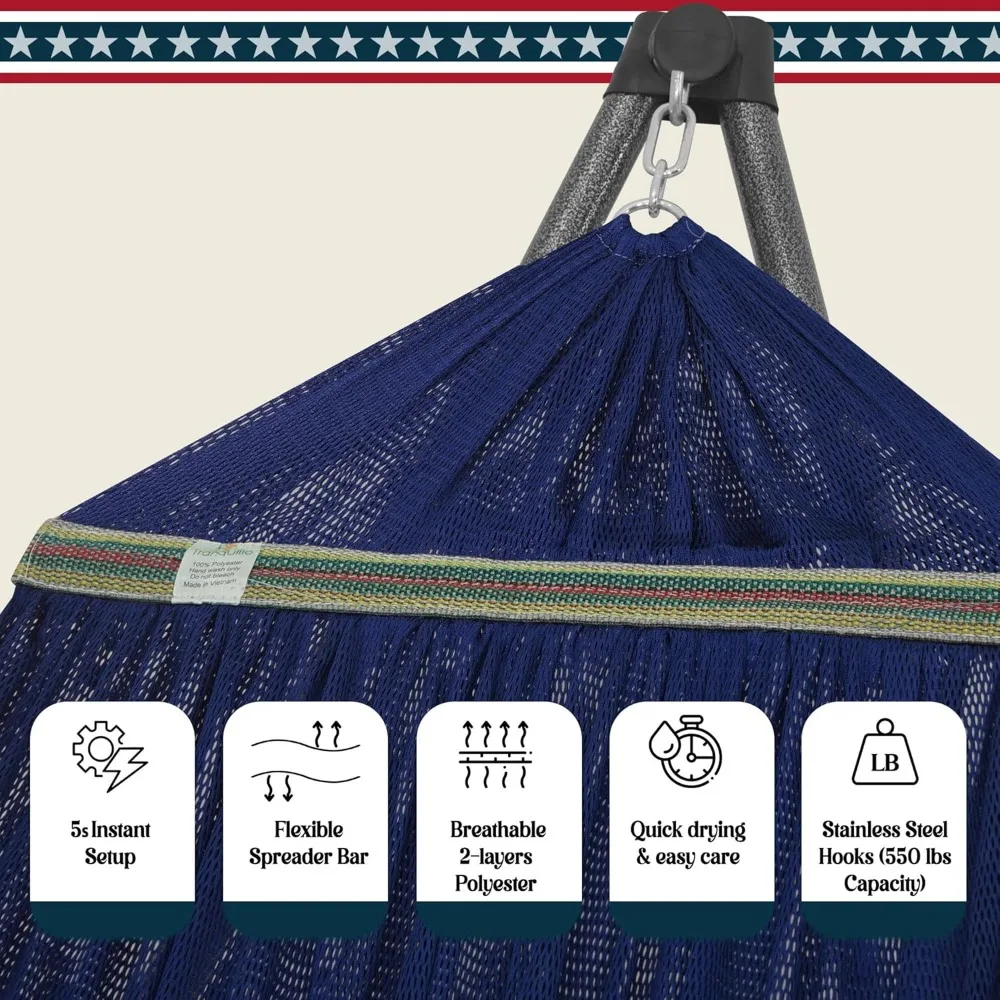
Hammocks with Integrated, Collapsible Stands
These ingenious all-in-one systems represent the ultimate in convenience, providing complete hammocks with built-in support frameworks that fold for transport. The engineering focuses on creating stable, self-supporting structures that deploy quickly without tools or technical knowledge.
Most designs use scissor-action or telescoping mechanisms that transform from compact bundles into sturdy frames in minutes. Frame materials typically balance weight considerations with necessary strength—aluminum offers lighter weight but may sacrifice some stability, while steel frames provide maximum security at the cost of additional pounds.
For vehicle storage, these systems typically fold into elongated bundles between 30-45 inches (76-114 cm) long and 6-10 inches (15-25 cm) in diameter. Setup usually involves unfolding the frame in a specific sequence, securing any locking mechanisms, and ensuring proper tension in the hammock fabric.
These systems excel in environments without natural hanging points—beaches, desert landscapes, grassy fields, or parking area rest stops. You can enjoy places to hang a hammock indoors between trips as well, making these systems versatile investments for year-round use.
Price ranges typically start around $120 and can exceed $250 for premium models with additional features like canopies or enhanced comfort elements.
Traditional Travel Hammocks (With Suspension Systems)
Representing the most packable approach, traditional travel hammocks consist of lightweight fabric that compresses into remarkably small bundles about the size of a softball or coffee mug. These systems achieve their extreme portability by separating the hammock from its suspension components.
The hammock itself typically uses ripstop nylon, parachute fabric, or high-tech polyester blends that offer strength without bulk. Modern suspension systems have evolved significantly from basic ropes to include tree-friendly straps with multiple attachment points for easy adjustment and specialized hardware that simplifies setup.
The primary advantage of these systems is their minimal vehicle footprint—many can fit in a glove compartment, door pocket, or small daypack. The trade-off comes in their dependency on finding suitable anchor points, typically trees spaced approximately 10-15 feet (3-4.5 meters) apart with adequate strength.
These hammocks shine in wooded areas, established campgrounds, or parks where natural anchor points abound. Many outdoor enthusiasts appreciate the “leave no trace” approach of tree-friendly suspension systems that distribute weight to prevent damage to bark.
Pricing for quality traditional travel hammocks typically ranges from $30-100 depending on fabric quality, weight capacity, and included suspension components.
Portable Hammock Stands (Separate Components)
This modular approach pairs traditional hammocks with separately transported portable stands. By separating these elements, users gain flexibility to mix and match components based on specific trip needs or to use their favorite hammock in both tree-mounted and free-standing configurations.
Portable stand designs vary dramatically—from tension-based systems using cables and poles to collapsible frame designs with multiple connecting pieces. Some prioritize minimal packed size with more complex assembly, while others focus on quick setup with slightly larger transport dimensions.
The advantage of this approach is its adaptability—you can bring just the hammock when trees are available or add the stand component when traveling to areas without natural suspension points. This flexibility comes with the trade-off of managing multiple components and potentially more complex setup procedures.
Vehicle space requirements vary significantly based on the stand design, but most require more room than fabric-only hammocks while still fitting in average car trunks. Setup times typically range from 5-10 minutes depending on the design complexity and user familiarity.
Cost analysis reveals this approach often represents a middle investment between ultra-portable hammocks and all-in-one systems, with quality stands ranging from $80-150 in addition to the hammock itself.
Essential Buying Guide: Choosing Your Perfect Road Trip Hammock
Finding your ideal road trip hammock requires matching product features to your specific travel habits and preferences. The perfect hammock for a cross-country expedition in a spacious SUV differs significantly from the optimal choice for weekend getaways in a compact car.
Each factor below represents a potential trade-off—greater comfort often means increased weight and size, while ultimate portability might sacrifice some convenience or comfort features. By understanding these relationships, you can prioritize what matters most for your travel style.
Use this guide alongside our product recommendations to identify which hammock aligns with your unique requirements. Consider how you’ll use the hammock, where you typically travel, and how much vehicle space you can reasonably dedicate to enhancing your rest breaks.
Knowing the best indoor and outdoor hammock locations can also help you determine which features will be most valuable for your typical stops.
Portability Factors: Weight and Packed Size
For road travelers, the size and weight of your hammock system directly impact how easily you can bring it along and how willing you’ll be to set it up during brief stops.
Vehicle space constraints vary dramatically—from spacious SUV cargo areas to the limited trunk space in compact cars or the minimal storage behind motorcycle seats. Consider your vehicle’s available space when evaluating hammock options, particularly if you travel with other gear.
Hammock weight categories generally fall into these ranges:
– Ultralight systems (under 1 lb/0.45 kg): Fabric-only hammocks with minimal suspension components
– Standard portable (1-5 lbs/0.45-2.27 kg): Traditional hammocks with complete suspension systems
– Stand-integrated systems (15+ lbs/6.8+ kg): Full hammock and stand combinations
Packed dimensions vary similarly:
– Ultracompact options compress to approximately the size of a large coffee mug
– Standard travel hammocks typically pack to about the size of a small shoe
– Frame-integrated systems generally fold to the length of a golf bag but with smaller diameter
When evaluating packed size, consider not just the volume but also the shape. Some systems pack into neat rectangles that stack efficiently with other gear, while others form irregular bundles that may waste surrounding space in your vehicle.
Modern stuff sack designs often incorporate compression straps that reduce volume by 20-30% through mechanical advantage. These features add particular value for fabric hammocks, allowing them to pack remarkably small.
Setup Speed and Simplicity
During road trips, the time required to transform your packed hammock into a comfortable relaxation spot dramatically affects how often you’ll actually use it. Complex systems that require substantial effort may remain unused during brief stops, negating their potential benefits.
Different hammock types present distinct setup challenges:
– Stand-integrated systems typically offer the fastest deployment (1-3 minutes) but require sufficient flat ground
– Traditional hammocks require finding suitable anchor points but can be hung quickly once located (3-5 minutes)
– Component systems with separate stands often require the most setup time (5-10 minutes) but offer maximum versatility
Consider whether you can realistically set up the hammock alone or if you’ll typically have assistance. Some larger frame systems become significantly easier with two people, while ultralight hammocks can be managed easily by one person.
Most hammock systems have an initial learning curve that diminishes with practice. More complex systems may require several uses before setup becomes intuitive, while simple designs might be self-explanatory from the first deployment.
Weather and environmental factors can dramatically impact setup time—strong winds make handling fabric challenging, cold temperatures can make metal components uncomfortable to manipulate, and rain may complicate the entire process. Systems with minimal components generally prove easier under challenging conditions.

Materials and Durability for Travel Conditions
The materials used in your hammock system determine not just its immediate comfort but also its longevity through repeated road trips and various environmental exposures.
Camping Hammock Sets with Bug Net, Ultralight Camping Hammock Sets
$139.72 Select options This product has multiple variants. The options may be chosen on the product pageFolding Hammock Sets, Quick Setup Hammock Sets
$305.52 – $583.27 Select options This product has multiple variants. The options may be chosen on the product pageCamping Hammock Sets with Bug Net, Complete Camping Hammock Systems
$82.73 – $97.96 Select options This product has multiple variants. The options may be chosen on the product pageFolding Hammock Sets, Lightweight Hammock Sets
$295.80 Select options This product has multiple variants. The options may be chosen on the product pageDouble / Two Person Hammock Sets, Folding Hammock Sets, Heavy Duty Hammock Sets
$323.71 – $486.23 Select options This product has multiple variants. The options may be chosen on the product page
Common hammock fabrics each offer distinct advantages:
– Ripstop nylon: Excellent strength-to-weight ratio with tear resistance
– Parachute nylon: Soft feel with good breathability and quick-drying properties
– Polyester: Superior UV resistance and minimal stretching when wet
For hammock stands, material choice significantly impacts both weight and durability:
– Aluminum: Lighter weight (30-40% less than steel) but may flex more under load
– Steel: Maximum stability and strength but adds considerable weight and potential for rust
Weather resistance becomes particularly important for road trip hammocks that may experience unpredictable conditions. Quality systems incorporate UV-stabilized fabrics, rust-resistant hardware, and water-repellent treatments to maintain performance across environments.
Regular cleaning during extended road trips helps prolong hammock life. Look for systems that allow easy spot cleaning or complete machine washing of fabric components. Metal stands generally need only occasional wiping down unless exposed to salt water or mud.
With proper care, quality hammock systems should last through multiple years of regular road trip use. Premium options may maintain their performance for 5+ years, while budget models might show significant wear after 1-2 seasons of frequent use.
Understanding proper hammock load capacity ensures both safety and long-term durability by preventing stress damage from exceeding design limits.
Comfort Features for Road Trip Relaxation
The ultimate purpose of bringing a hammock on your road trip is enhanced relaxation during breaks, making comfort features worth careful consideration.
Ergonomic design elements significantly impact how your body feels during and after hammock use. Look for systems that:
– Allow for diagonal positioning to create a flatter lay
– Provide sufficient length to prevent calf ridge pressure
– Offer adequate width for unrestricted movement
– Maintain proper support without excessive sagging
Dimensional factors directly influence comfort:
– Length: Ideally 8+ feet (2.4+ meters) for average adults
– Width: Minimum 4.5 feet (1.4 meters) for single users, 6+ feet (1.8+ meters) for doubles
– Suspension height: Typically 18-24 inches (45-60 cm) at center when weighted
Fabric breathability becomes particularly important during warm weather travel, with more open weaves allowing better air circulation. Some premium hammocks incorporate strategic ventilation panels to enhance temperature regulation.
The classic hammock “cocoon” effect (edges wrapping around you) provides security for some users but feels claustrophobic to others. Hammocks with spreader bars or rigid frame elements maintain a flatter, more open feel that many road travelers prefer for daytime lounging.
Additional comfort enhancements might include integrated pillows, padded edges to reduce pressure points, or specialized suspension systems that create more ergonomic body positioning.
Weight Capacity and User Considerations
Safety and comfort both depend on choosing a hammock system with appropriate weight capacity for all intended users. Manufacturers provide maximum weight ratings, but experienced hammockers recommend staying at least 50-75 pounds (22.7-34 kg) below this limit for optimal comfort and longevity.
Single hammocks typically support 250-350 pounds (113-159 kg), while double versions often accommodate 400-500+ pounds (181-227+ kg). These capacities assume proper installation according to manufacturer guidelines.
For stand-based systems, frame stability becomes particularly important. Quality designs distribute weight effectively through triangulation or other structural engineering principles. Wider base footprints generally indicate better stability at the cost of increased packed size.
Taller users (over 6 feet/183 cm) should pay special attention to hammock length, as insufficient dimensions can create uncomfortable pressure points or unnatural sleeping positions. Many manufacturers now offer extended-length options specifically addressing this need.
Weight distribution varies significantly between hammock designs. Traditional gathered-end hammocks naturally create a center point that accepts most body weight, while spreader-bar designs distribute weight more evenly across the entire fabric surface.
Safety standards for quality hammocks include reinforced stitching at stress points, redundant suspension attachments, and clear usage guidelines. Reputable manufacturers thoroughly test their products under various conditions to ensure they meet or exceed stated capacities.
Additional Features and Accessories
While basic hammock functionality requires only the suspension system and fabric body, thoughtfully chosen accessories can dramatically enhance the road trip experience.
Integrated features versus separate accessories represents a fundamental choice. Built-in elements offer convenience but limited customization, while modular approaches allow tailoring to specific trips but require managing additional components.
Insect protection becomes essential in many environments, with options including:
– Built-in mosquito netting (permanently attached or zippered)
– Separate bug net sleeves that envelop existing hammocks
– Permethrin-treated fabrics that repel insects without additional components
Weather protection systems expand usability across conditions:
– Dedicated hammock tarps with asymmetric designs matching typical hanging angles
– Integrated rain flies on premium models
– Waterproof stuff sacks that double as water collectors in emergency situations
Storage solutions prevent small items from getting lost during relaxation:
– Internal pockets sewn into hammock sides
– Attachable gear organizers that hang beside or below the hammock
– Ridgeline organizers for flashlights, phones, or water bottles
For travelers exploring varied climates, insulation accessories like underquilts provide critical temperature management when hanging in cooler conditions. These specialized components eliminate the compressed insulation problem inherent to using sleeping bags in hammocks.
Our collection of camping hammocks with integrated bug nets offers protection without additional components, simplifying setup while ensuring comfortable, insect-free relaxation.
Budget Considerations and Value Assessment
Hammock pricing spans a wide range, making budget considerations an important factor in selection. Rather than focusing solely on initial cost, evaluate the value proposition—how the features, durability and versatility align with your specific road trip needs.
Price categories generally break down as follows:
– Budget options ($30-75/€27-68): Basic functionality with fewer comfort features
– Mid-range selections ($75-150/€68-136): Better materials, enhanced comfort, included accessories
– Premium offerings ($150+/€136+): Maximum comfort, durability, integrated features
Value assessment extends beyond initial purchase price to consider:
– Expected lifespan under your usage patterns
– Versatility across different environments
– Included accessories that would otherwise require separate purchase
– Warranty coverage and manufacturer support
For frequent road travelers, investing in higher-quality systems often proves economical over time, as premium hammocks typically outlast budget alternatives by several years. Occasional users might reasonably prioritize lower initial cost over maximum longevity.
A useful metric for evaluation is “cost per use”—dividing the purchase price by the estimated number of times you’ll use the hammock. For weekly road-trippers, even premium systems often cost less than $1/€0.90 per use over their lifespan, while providing significantly enhanced rest experiences.
Maximizing Your Road Trip Hammock Experience
Having selected the right hammock for your travels, understanding how to integrate it effectively into your road trip routine maximizes its benefits. Strategic planning about when and where to deploy your hammock transforms it from merely another piece of gear into a trip-enhancing tool for better rest and more meaningful connections with beautiful surroundings.
The following practical advice helps you identify optimal hammock opportunities, streamline setup processes, and enhance your relaxation sessions with thoughtfully chosen accessories. By incorporating these approaches, you’ll find yourself naturally reaching for your hammock more frequently, enriching your travel experience with quality rest moments.
Perfect Road Trip Locations for Hammock Setup
The ideal hammock location balances practical setup requirements with environmental quality for maximum relaxation benefit. As you plan your route, consider these hammock-friendly stopping points:
Traditional established locations offer predictable hammocking opportunities:
– State and national park picnic areas (check regulations regarding hammock use)
– Developed campgrounds with designated recreation areas
– Public beaches with permitted hammock zones
– Traveler rest areas with tree groves or open spaces
Opportunistic spots require more awareness but often provide superior experiences:
– Scenic overlooks with sufficient space off main viewing areas
– Public land access points with appropriate natural features
– Quiet secondary roads with safe pullout areas
– Urban parks in towns along your route
When assessing potential locations, consider these factors:
– Shade availability during your planned stop time
– View quality and noise levels
– Ground surface conditions for stand-based systems
– Privacy level appropriate to your comfort preferences
– Proximity to your vehicle for convenience
Understanding permission and regulations prevents uncomfortable encounters—many parks have specific rules about hammock use to protect trees or limit impact. Some areas permit hammocks only with tree-friendly straps, while others prohibit them entirely.
Safety considerations should include:
– Adequate distance from traffic
– Awareness of surrounding tree health for hanging systems
– Avoidance of areas with overhead hazards
– Reasonable proximity to facilities if needed
For stand-based hammocks, seek reasonably flat ground clear of sharp objects that might damage the base or create instability. For traditional hanging systems, identify healthy trees with appropriate diameter and spacing (typically 10-15 feet/3-4.5 meters apart).
Quick-Start Setup Guide for Different Scenarios
Efficient hammock deployment makes the difference between frequent enjoyable use and leaving your hammock perpetually packed. These streamlined procedures help you transition from driving to relaxing in minimal time.
For stand-integrated systems:
1. Select a flat area larger than the stand’s footprint
2. Remove the system from its carrying case
3. Unfold the main frame to its full extension
4. Secure any locking mechanisms or stabilizing elements
5. Adjust hammock tension if necessary
6. Test stability before fully committing your weight
For traditional tree-hanging hammocks:
1. Identify appropriate trees with healthy bark and adequate diameter
2. Wrap tree straps around each trunk at 5-6 feet (1.5-1.8 meters) height
3. Attach hammock ends to straps using included hardware
4. Make preliminary tension adjustments
5. Test with partial weight before fully reclining
6. Fine-tune height and tension for optimal comfort
When setting up on uneven terrain:
– Position stand-based systems with the head end slightly higher
– For hanging systems, adjust strap heights to compensate for ground slope
– Use natural features to your advantage for optimal positioning
Safety checks before full weight application should include:
– Confirming all connection points are properly secured
– Verifying stand legs are fully extended and locked
– Ensuring tree straps have not twisted during setup
– Testing stability with partial weight application
For brevity during short stops, consider leaving tree straps in place while packing the hammock if you’ll return to the same location, or develop a personalized sequence that minimizes unnecessary steps based on your specific hammock system.
Essential Accessories for Enhanced Hammock Breaks
Thoughtfully chosen accessories transform basic hammock use into a comprehensive relaxation experience without significantly increasing your packed load.
Weather protection accessories prove invaluable during unpredictable road conditions:
– Lightweight hammock tarps deploy quickly over hanging systems
– Compact sun shades provide UV protection during summer travels
– Hammock under-covers block wind during cooler conditions
Comfort enhancers dramatically improve relaxation quality:
– Small inflatable or compressible pillows support proper neck alignment
– Lightweight blankets extend seasonal use into cooler weather
– Underquilts prevent “cold butt syndrome” by insulating underneath
Convenience items make hammock time more enjoyable:
– Drink holders that attach to hammock sides or stands
– Phone/device pockets with protective weather flaps
– Small battery-powered LED lights for evening relaxation
To maximize vehicle space efficiency, look for multi-purpose items that serve hammock and non-hammock functions—microfiber towels that double as light blankets, packable jackets that serve as pillows, or water bottles that fit both vehicle cup holders and hammock accessories.
Quick-attach systems using carabiners, toggles, or hook-and-loop fasteners allow rapid deployment without complicated installation. These approaches particularly benefit travelers making frequent shorter stops who need to minimize setup time.
The collection of lightweight folding hammocks for parks and picnics demonstrates how versatile accessory integration can enhance your experience across various outdoor settings.
Top 8 Questions About Folding Hammocks for Road Trips
What hammock options work without trees or anchor points?
Hammocks with integrated stands provide complete independence from environmental anchor points. These self-contained systems use folding frames that deploy on any reasonably flat surface. Another option is portable hammock stands that pair with traditional hammocks—these separate components offer more flexibility but require more assembly time. Some ultra-portable stands use tension-based designs with ground stakes for stability, offering a middle ground between weight and convenience.
How much vehicle space do folding hammocks typically require?
Space requirements vary dramatically by type. Traditional fabric hammocks with suspension systems typically pack down to about the size of a large water bottle (roughly 8 × 5 × 5 inches/20 × 13 × 13 cm). Stand-integrated systems generally fold to cylinder-shaped bundles approximately 30-45 inches (76-114 cm) long and 6-10 inches (15-25 cm) in diameter—similar to a medium duffel bag or small camping chair. Component systems with separate stands and hammocks require space for both but offer flexibility to bring only what’s needed for each specific trip.
Are hammocks comfortable enough for actual sleeping during overnight stops?
Many travelers find properly set up hammocks more comfortable than vehicle sleeping. The key factors are diagonal positioning (lying at an angle to the centerline) which creates a flatter surface, proper sag adjustment, and appropriate insulation underneath. Dedicated hammock campers regularly sleep full nights in their systems. However, personal preference plays a significant role—some people adapt immediately while others find the curved position challenging. For road trips, hammocks excel for naps and rest breaks even if you prefer traditional accommodations for overnight sleeping.
What’s the average setup time for different folding hammock types?
Stand-integrated hammocks typically set up fastest, averaging 1-3 minutes once you’re familiar with their mechanism. Traditional hanging hammocks require 3-5 minutes including finding suitable trees and adjusting tension. Component systems with separate stands typically take longest at 5-10 minutes due to multiple assembly steps. All systems become significantly faster with practice as you develop muscle memory for the sequence. Environmental factors like wind, limited space, or uneven ground can increase setup time for any system.
How do folding hammocks compare to traditional camping chairs for road trips?
Folding hammocks offer superior comfort through elevated, full-body support that eliminates pressure points common in chairs. They provide a true lying position ideal for napping, unlike the seated posture of chairs. However, hammocks typically require more setup time and often more space than ultra-compact chairs. They’re also less practical for activities requiring an upright position like eating or writing. Many road travelers bring both—chairs for quick stops and meals, hammocks for longer breaks when relaxation is the priority.
What weight capacity should I look for if I’m above average size?
For users over 200 pounds (91 kg), look for hammocks rated at minimum 350 pounds (159 kg) to provide an adequate safety margin. Double hammocks typically offer higher weight capacities (400-500 pounds/181-227 kg) and wider dimensions that better accommodate larger frames. Pay particular attention to the stand capacity if using a frame-based system, as this may differ from the hammock fabric rating. For maximum comfort and longevity, stay at least 75-100 pounds (34-45 kg) under the manufacturer’s stated maximum capacity.
Can folding hammocks withstand constant packing and unpacking during trips?
Quality hammocks are designed for repeated deployment. Look for reinforced stitching at stress points, robust fabric with ripstop construction, and quality hardware connections. Premium hammocks use materials specifically chosen for cycle durability—the ability to withstand repeated folding and unfolding. Stand-integrated systems should feature positive locking mechanisms that minimize stress on hinge points. With proper care, quality hammocks easily withstand dozens or even hundreds of setup cycles before showing significant wear.
What hammock features are worth paying extra for on road trips?
The most valuable premium features for road travelers include quick-deploy mechanisms that minimize setup time, truly compact folding designs that save vehicle space, and integrated sun/rain protection for weather versatility. Enhanced comfort features like ergonomic fabric tensioning and breathable yet supportive materials significantly improve relaxation quality. For frequent users, superior materials that resist UV degradation and maintain performance longer justify higher initial investment. Conversely, elaborate accessory attachment systems or heavyweight “glamping” features may add unnecessary bulk and complexity for typical road trip scenarios.

